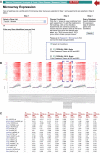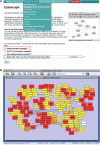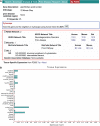The Prion Disease Database: a comprehensive transcriptome resource for systems biology research in prion diseases
- PMID: 20157484
- PMCID: PMC2790306
- DOI: 10.1093/database/bap011
The Prion Disease Database: a comprehensive transcriptome resource for systems biology research in prion diseases
Abstract
Prion diseases reflect conformational conversion of benign isoforms of prion protein (PrP(C)) to malignant PrP(Sc) isoforms. Networks perturbed by PrP(Sc) accumulation and their ties to pathological events are poorly understood. Time-course transcriptomic and phenotypic data in animal models are critical for understanding prion-perturbed networks in systems biology studies. Here, we present the Prion Disease Database (PDDB), the most comprehensive data resource on mouse prion diseases to date. The PDDB contains: (i) time-course mRNA measurements spanning the interval from prion inoculation through appearance of clinical signs in eight mouse strain-prion strain combinations and (ii) histoblots showing temporal PrP(Sc) accumulation patterns in brains from each mouse-prion combination. To facilitate prion research, the PDDB also provides a suite of analytical tools for reconstructing dynamic networks via integration of temporal mRNA and interaction data and for analyzing these networks to generate hypotheses.Database URL:http://prion.systemsbiology.net.
Figures





Similar articles
-
A systems approach to prion disease.Mol Syst Biol. 2009;5:252. doi: 10.1038/msb.2009.10. Epub 2009 Mar 24. Mol Syst Biol. 2009. PMID: 19308092 Free PMC article.
-
Disulfide-crosslink scanning reveals prion-induced conformational changes and prion strain-specific structures of the pathological prion protein PrPSc.J Biol Chem. 2018 Aug 17;293(33):12730-12740. doi: 10.1074/jbc.RA117.001633. Epub 2018 Jun 22. J Biol Chem. 2018. PMID: 29934306 Free PMC article.
-
Flow Cytometric Detection of PrPSc in Neurons and Glial Cells from Prion-Infected Mouse Brains.J Virol. 2017 Dec 14;92(1):e01457-17. doi: 10.1128/JVI.01457-17. Print 2018 Jan 1. J Virol. 2017. PMID: 29046463 Free PMC article.
-
Understanding Intra-Species and Inter-Species Prion Conversion and Zoonotic Potential Using Protein Misfolding Cyclic Amplification.Front Aging Neurosci. 2021 Aug 3;13:716452. doi: 10.3389/fnagi.2021.716452. eCollection 2021. Front Aging Neurosci. 2021. PMID: 34413769 Free PMC article. Review.
-
Virus Infection, Genetic Mutations, and Prion Infection in Prion Protein Conversion.Int J Mol Sci. 2021 Nov 18;22(22):12439. doi: 10.3390/ijms222212439. Int J Mol Sci. 2021. PMID: 34830321 Free PMC article. Review.
Cited by
-
Identification of Major Signaling Pathways in Prion Disease Progression Using Network Analysis.PLoS One. 2015 Dec 8;10(12):e0144389. doi: 10.1371/journal.pone.0144389. eCollection 2015. PLoS One. 2015. PMID: 26646948 Free PMC article.
-
Microglia regulate hippocampal neurogenesis during chronic neurodegeneration.Brain Behav Immun. 2016 Jul;55:179-190. doi: 10.1016/j.bbi.2015.11.001. Epub 2015 Nov 2. Brain Behav Immun. 2016. PMID: 26541819 Free PMC article.
-
A Common Phenotype Polymorphism in Mammalian Brains Defined by Concomitant Production of Prolactin and Growth Hormone.PLoS One. 2016 Feb 19;11(2):e0149410. doi: 10.1371/journal.pone.0149410. eCollection 2016. PLoS One. 2016. PMID: 26894278 Free PMC article.
-
Disrupted SOX10 function causes spongiform neurodegeneration in gray tremor mice.Mamm Genome. 2015 Feb;26(1-2):80-93. doi: 10.1007/s00335-014-9548-5. Epub 2014 Nov 16. Mamm Genome. 2015. PMID: 25399070 Free PMC article.
-
Reversal of mitochondrial defects with CSB-dependent serine protease inhibitors in patient cells of the progeroid Cockayne syndrome.Proc Natl Acad Sci U S A. 2015 Jun 2;112(22):E2910-9. doi: 10.1073/pnas.1422264112. Epub 2015 May 18. Proc Natl Acad Sci U S A. 2015. PMID: 26038566 Free PMC article.
References
-
- Hood L, Heath JR, Phelps ME, et al. Systems biology and new technologies enable predictive and preventative medicine. Science. 2004;306:640–643. - PubMed
-
- Lin B, White JT, Lu W, et al. Evidence for the presence of disease-perturbed networks in prostate cancer cells by genomic and proteomic analyses: a systems approach to disease. Cancer Res. 2005;65:3081–3091. - PubMed
-
- Price ND, Edelman L, Lee I, et al. Systems biology and the emergence of systems medicine. In: Willard HF, Ginsburg GS, editors. Genomic and Personalized Medicine: From Principles to Practice. I. New York: Academic Press; 2009. pp. 74–85.
-
- Prusiner SB. Prion Biology and Diseases. 2nd. 2003. Cold Spring Harbor Laboratory Press, pp. 1–88. - PubMed
LinkOut - more resources
Full Text Sources
Research Materials

